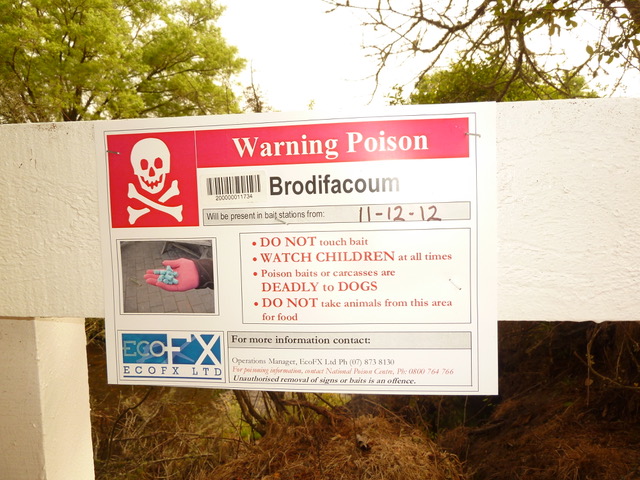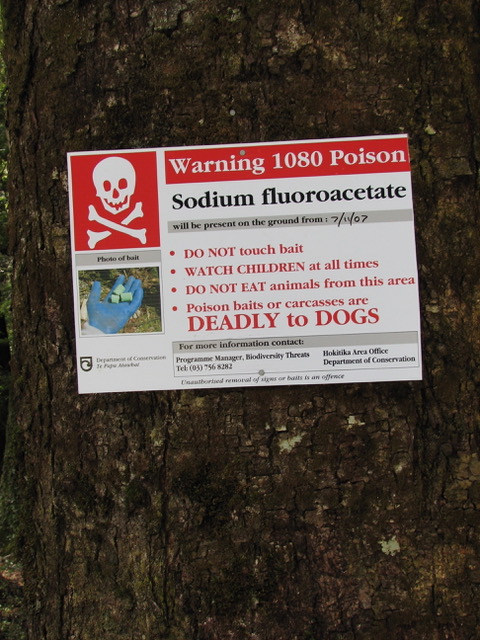by Tony Orman
The Department of Conservation is farming rats and stoats by indulging in mass aerial poisoning of New Zealand’s wilderness areas.
Scientific research shows that following an aerial 1080 drop, some 15 percent of rats that inevitably survive the rain of toxic, lethal, slow killing 1080 poison laced pellets, multiply prodigiously.
The late Bill Benfield meticulous researcher and Wairarapa conservationist in his book “The Third Wave” wrote that research by Graham Nugent and Peter Sweetapple before and after an aerial drop of 1080 – entitled “Secondary Effects of Possum Control 2007” – examined two 1080 drops, one at Mokau in north Taranaki and the other at Waihaha, Western Bays, Lake Taupo.

Bill Benfield – author of “The Third Wave”
The two scientists found there was an initial collapse of rat populations following an aerial 1080 operation — then rats recovered numbers to around the pre-poisoning level—-within twenty months.
Other studies have found similar rat population explosions that within a few short years after the poisoning soared to “four times greater than it had been before.”
The meddling by 1080 poisoning operations with the equilibrium of Nature’s food chain causes tsunamis of population disruptions with other species. Also monitored in the studies before and after the 1080 drops, were insect and robin populations.
Insects showed an initial jump in numbers following poisoning as the number of rats which prey on invertebrates had plummeted to about 15 percent of pre-poisoning numbers. But as the surviving rats with abundant feed accelerated their breeding, insects declined massively as the rat population exploded.
Food chains and predator/prey relationships are really simple.
Other species such as insects, bird life and predators of rats come into the reckoning. With rat numbers initially slashed, insects and birds became more abundant.
But it is short-lived.
Rat numbers recover with incredible speed, testimony to their incredible reproductive ability.
“A year or two after the event, both birds and insects will be under pressure from plagues of rats” wrote Bill Benfield.
Add in a developing complication with stoats.
Rats are the number one prey of stoats.
Following the initial knock back of rat numbers by 1080, stoats are forced to switch diet from rats – no longer available – to birds. But as rat numbers climb back and surge upwards, the massive disruption to the ecosystem then brings in an explosion of stoats which thrive with the increased food supply of rats.
So all the Department of Conservation has achieved with aerial 1080 drops is firstly a population explosion of rats followed by a strong surge in stoat numbers.
But the ecological mayhem does not stop there. Birds get poisoned due to varying character circumstances between species:-
(1) Birds that survive by being generalist, inquisitive, opportunistic feeders such as robins, weka and kea will peck at baits.
(2) Predators such as kiwi (with worms) or moreporks (with insects or mice), or native falcons (with birds or perhaps mice) will be attracted by their prey’s distress since 1080 kills slowly and convulsively. Predators are opportunistic by nature.
(3) Any carcass killed by 1080 retains its toxicity. So scavengers such as hawks and weka get poisoned too.
Insects
While the science points to devastating effects by 1080 on birds, another species comes into play, i.e. insects.
The poison 1080, according to Bill Benfield’s book “The Third Wave” and other sources, was originally patented in 1927 as an insecticide. So insects and other invertebrates now enter the equation.
Noted entomologist the late Mike Meads in the mid-1990s examined the effect of aerially spread 1080 on the forest floor following a poison drop at Whitecliffs, Taranaki.
Invertebrates are vital in the ecological life of the forest floor’s litter. Following his field research, Mike Meads expressed alarm that the forest floor insects and micro-organisms responsible for the natural breakdown of forest litter were severely and adversely impacted by aerial 1080.
In an interview with “Rural News” in 1995 he was reported as warning “continue to apply 1080 and you will end up with knee deep leaves because they are not breaking down.”
He warned the loss of forest floor insects and organisms so important to the natural process of decomposting would deprive the kiwi and other ground living creatures of much of their diet. The Meads study found about 50 percent of the invertebrates were killed with each 1080 drop.
Mike Meads had dared to challenge the traditional departmental culture and poison policy of the Department of Conservation.
The onslaught was devastating and stressful on the scientist. He was vilified within the department with a “kangaroo court” style departmental peer review rubbishing his studies and he was soon “awarded” redundancy for his integrity.
The hapless scientist had urged the department to implement “long term monitoring” in order to assess and understand the ecological damage that was ongoing.
in an interview shortly before his death Mike Meads said DoC was “just fiddling around, not knowing what was killing what by what rate”. He rued that in 14 years since his Taranaki study that despite “everyone in the department agreeing, not even one long term monitoring had been started.”

Brodifacoum- even more inhumane and more lethal than 1080
Back to Rats
So to return to rats. It’s necessary to understand the incredible breeding potential of rats.
A female can become pregnant at just six weeks of age. “Ship rats breed seasonally from spring to autumn in most areas, but this can extend to year-round breeding or even winter breeding in years with abundant food, such as beech forest mast-seeding events. A female ship rat can produce multiple litters of up to 10 offspring in a single year.”
Potentially and with abundant food as occurs after a poison drop, a surviving female rat is capable of producing towards 100 offspring a year.
Beech Mast Years
Frequently the Department of Conservation endeavours to justify a 1080 aerial drop by citing an anticipated beech mast year. A mast year is when beech trees flower and produce a large quantity of seeds. In New Zealand, beech trees generally have a “mast year” or widespread seeding event every 2-6 years, with a significant event, a “mega-mast”, happening less frequently.
But beech mast years are far from a new event.
Beech trees have a long evolutionary history, with their lineage dating back to the Late Cretaceous period, about 81-82 million years ago during which time, mast years have naturally occurred.
The alibi of a beech mast year just doesn’t stand up to scrutiny.
So rat numbers naturally fluctuate from year to year dependent on food supply. In a mast year there is a natural increase in rat numbers, but as food supply drops the next year so too do rat numbers.
Nature knows.
But the intervention of a widespread and intensive 1080 drop throws the natural cycles into catastrophic disarray.
A Pattern Emerges
And an examination of the department’s 1080 drops reveals an emerging pattern. Reiterating from earlier “Two years after the poisoning operation, rat abundance was about four times greater than it had been before.”
Two years. It may be three or four years in some cases —but “every few years”.
Some recent 1080 poison operations are chronological proof of the fallacy.
This October, DoC will drop 1080 over the Oparara/Karamea area of the West Coast. It was last poisoned in February 2023 – two years ago.
“The Abbey Rocks area in South Westland receives regular 1080 drops, often every two years,” says the department. “Often every two years.”
In the Landsborough valley a tributary of the Haast River, DoC first poisoned the valley in 1994 and since then, every few years, has done eight aerial 1080 operations each timed with increasing rodent levels. The most recent 1080 operation was in 2024 due to “increasing rodent levels.”
The Lewis Pass area is to be poisoned this November. It was poisoned early last year – about two years gap. The department cites “unexpected heightened seed fall—with subsequent high rat numbers.”
The pattern emerges that every few years, as rat numbers explode after a 1080 aerial drop, and numbers soar, the department decrees that another 1080 drop is needed.
It is self perpetuating and self benefiting the department, with naive government politicians giving vote allocation money to the bureaucracy. The departments spin doctors go into high gear to ring alarm bells.
A typical 1080 aerial drop is estimated to cost between $2 million and $3 million.
As an old bushman said to me, “All Doc is doing with 1080 is causing population booms in rats and stoats and knocking birds and insects around. You might say DoC are farming rats and stoats.”
Footnote: “The Third Wave” by Bill Benfield is available from Tross Publishing via Google.


Mast years are the years birds thrive and reproduce in larger numbers than normal because of larger amounts of food available but instead of a good breeding season their numbers are reduced by 1080 poison.
It’s not surprising that rat numbers bounce back after 1080. They are extremely prolific breeders, reaching sexual maturity as soon as 4 to 5 weeks, with a gestation period of 21 to 23 days. Females have large litters – up to 13 pups and can mate soon after giving birth to a litter. A female rat usually has six litters a year.
So that means in good conditions with abundant food after a 1080 operation six time a dozen means one female produces over 70 youngsters in a year.
Of course those female youngsters at 5 weeks of age can become pregnant and give birth 21 or so days later.
I note one source says “a population can swell from two rats to around 1,250 in one year, with the potential to grow exponentially.”
Why can’t DoC and OSPRI understand that?
Why can’t successive Ministers of Conservation understand that?
Thanks “Eco-sense.”
By the way who is the Minister of Conservation?
Conspicuous by his absence.
Some years ago I did a research study at Canterbury University on the fecundity of feral mice in North Canterbury. We showed that a female mouse is fertile at 42 days of age. She will produce an average litter of six (survival depends on food supply). She can produce a new litter every 25 days. To make the maths easy lets assume that she is 50 days old when she starts. After she is 150 days old she has produced 12 offspring of which 6 will be females. The first 3 will already be pregnant. So after 200 days the original mouse has 12 female offspring and her first born have produced another 6 each and the second litter another 3 each. I believe that equates to around 200 females or 400 mice over six months of good food supply, i.e. a mast year. The survival rate may even be higher. A feral mouse can live up to 2 years. They are great travelers and swimmers and don’t stick around if food is diminishing. That’s why trout often get the chance to dine out on mice.
A species that can conservatively expand its population by 20,000 percent in a mast season will not start nibbling 1080 until the beech seed supply diminishes. Even then it is more likely to migrate.